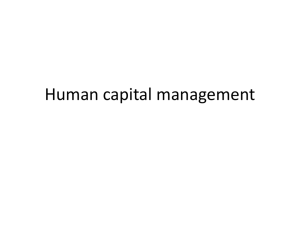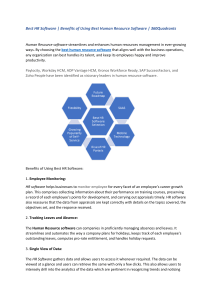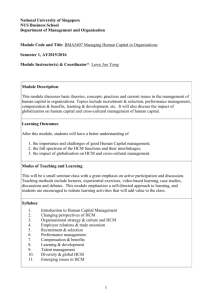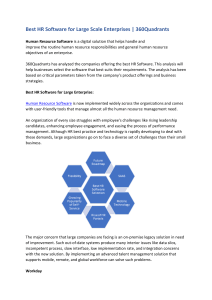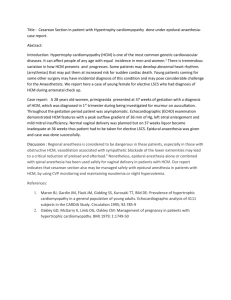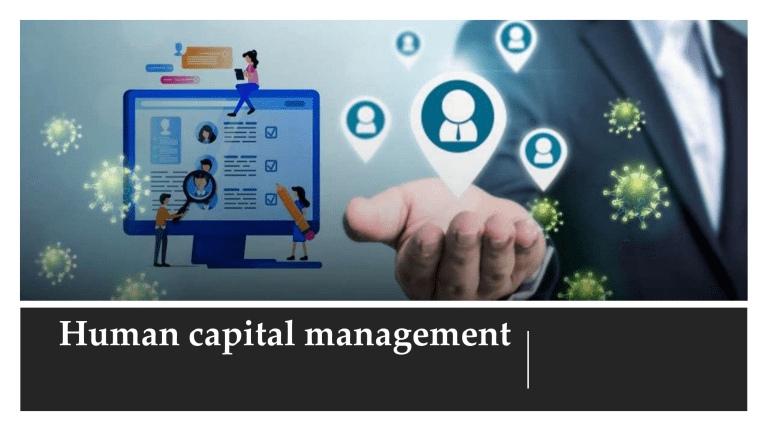
Human capital management Introduction The word “Human Capital” was introduced by A. W. Lewis. Human capital consists of the knowledge, skills and abilities of the people employed in an organization. According to Lawrence Bossidy an American author and former Signal, CEO of Allied later Homewell. “I am convinced that nothing we do is more important than hiring and developing people. At the end of the day, you bet on people, not on strategies.” Definition Human capital represents the human factor in the organization; the combined intelligence, skills and expertise that gives the organization its distinctive character. The human elements of the organization are those that are capable of learning, changing, innovating and providing the creative thrust which if properly motivated can ensure the long-term survival of the organization. Bontis et al (1999) Constituents of human capital Human capital consists of : Intellectual capital • Intellectual capital is the value of a company's employee knowledge, skills, business training, or any proprietary information that may provide the company with a competitive advantage. Social capital • Social capital consists of the knowledge derived from networks of relationships within and outside the organization Organizational capital • Organizational capital is the institutionalized knowledge possessed by an organization that is stored in databases, manuals, patents etc. Components of Human Capital Organizational capital Social capital Human capital • the knowledge,skills, abilities and capacity to develop and innovate possessed by people in an organization • the structures, networks and procedures that enable those people to acquire and develop intellectual capital represented by the stocks and flows of knowledge derived from relationships within and outside the organization • the institutionalized knowledge possessed by an organization which is stored in databases, manuals etc. • These include HR policies and processes used to manage people. • Also known as structural capital. 3 Meaning: Human capital management Human capital management (HCM) transforms the traditional administrative functions of human resources (HR) departments— recruiting, training,payroll, compensation, and performance management— into opportunities to drive engagement, productivity, and business value. Human capital management Human capital management (HCM) is the set of practices an organization uses for recruiting, managing, developing, and optimizing employees to increase their value to the company. What’s the strategic importance of implementing HCM Automation is changing the workforce Importance of Human capital management Managing a company's people resources. Enhance the recruitment process Identify gaps in the capabilities of the workforce. Align human capital management with business goals Allows better career planning Improve productivity and efficiency Improve performance reviews Match positions with employee capabilities Improve organic growth by identifying the competencies of individual employees Human capital management drivers Driver 1 Leadership Practices Driver 2 Employee Engagement Driver 3 Knowledge Accessibility Communication Key Responsibility Areas Information Availability Inclusiveness Driver 5 Learning Capacity Work processes Innovation Working Conditions Commitment Team Work Supervision Driver 4 Workforce Optimization Accountability Time management Hiring Leadership Evaluation Information Sharing Training Performance Management Career Development Learnings Human capital theory • It regards people as assets and focus that investment by organizations in people will generate worthwhile returns • It propose that sustainable competitive advantage is attained when the firm has a human resource pool that cannot be imitated or substituted by its rivals. • Human capital theory helps to: Determine the impact of people on the business and their contribution to shareholder value; Demonstrate that HR practices produce value for money in terms, for example, of return on investment; Provide guidance on future HR and business strategies; provide data that will inform strategies and practices designed to improve the effectiveness of people management in the organization. START Human capital measurement Human capital measurement has been defined by IDS (2004) as being ‘about finding links, correlations and, ideally, causation, between different sets of (HR) data, using statistical techniques’. The primary aim of HCM is to assess the impact of human resource management practices and the contribution made by people to organizational performance. Reasons for interest in human capital measurement •Human capital constitutes a key element of the market worth of a company •People in organizations add value. •Focus attention on what needs to be done to make the best use of human capital. •Monitor progress in achieving strategic HR goals and evaluate HR practices. •You cannot manage unless you measure. Approaches to Human capital measurement 1. The human capital index – Watson Wyatt 2. The organizational performance model – Mercer HR Consulting 3. The human capital monitor – Andrew Mayo 4. The balanced scorecard 5. European Foundation for Quality Management (EFQM) model 6. The Sears Roebuck model The human capital index (HCI) – Watson Wyatt Categories Percentage • Total rewards and accountability 16.5 percent • Collegial, flexible workforce 9.0 percent • Recruiting and retention excellence 7.9 percent • Communication integrity 7.1 percent The organizational performance model – Mercer HR Consulting Organizational performance model developed by Mercer HR Consulting is based on the following elements: People Work processes Management Structure Information and knowledge Decision making Rewards • Each elements plays out differently within the context of the organization, creating a unique DNA. • The statistical tool, ‘Internal Labour Market Analysis’ used by Mercer scrutinize the record of employee and labour market data to analyse the actual experience of employees rather than stated HR programmes and policies • Thus gaps can be identified between what is required in the workforce to support business goals and what is actually being delivered. The human capital monitor – Andrew Mayo Mayo has developed the ‘human capital monitor’ to identify the human value of the enterprise or ‘human asset worth’, which is equal to ‘employment cost × individual asset multiplier’. The individual asset multiplier is a weighted average assessment of capability, potential to grow, personal performance (contribution) and alignment to the organization’s values set in the context of the workforce environment (ie how leadership, culture, motivation and learning are driving success). He believes that value added per person is a good measure of the effectiveness of human capital This Photo by Unknown Author is licensed under CC BY EFQM model of quality • The European Foundation for Quality Management (EFQM) model indicates that customer satisfaction, people (employee) satisfaction and impact on society are achieved through leadership. • This drives the policy and strategy, people management, resources and processes required to produce excellence in business results. The EFQM model 1.Leadership – how the behaviour and actions of the executive team and all other leaders inspire, support and promote a high performance culture. 2.Policy and strategy – how the organization formulates, deploys and reviews its policy and strategy and turns them into plans and actions. 3. People management – how the organization realizes the full potential of its people. 4. Resources – how the organization manages resources effectively and efficiently. 5. Processes – how the organization identifies, manages, reviews and improves its processes. 6. Customer satisfaction – what the organization is achieving in relation to the satisfaction of its external customers. 7. People satisfaction – what the organization is achieving in relation to the satisfaction of its people. 8.Impact on society – what the organization is achieving in satisfying the needs and expectations of the local, national and international community at large. 9.Business results – what the organization is achieving in relation to its planned business objectives and in satisfying the needs and expectations of everyone with a financial interest or stake in the organization. The Sears Roebuck model (Rucci et al, 1998) • The Sears Roebuck model defines the employee-customer-profit chain. It is sometimes called the ‘engagement model’. • It explains that if you keep employees satisfied in terms of their attitude to the company and their job you will create a ‘compelling place to work’, which will encourage retention and lead to service helpfulness and merchandize value, which leads to customer satisfaction, retention and recommendations, thus creating ‘a compelling place to shop’. • This in turn creates ‘a compelling place to invest’, because of its impact on return on assets, operating margins and revenue growth This Photo by Unknown Author is licensed under CC BY The balanced scorecard A balanced scorecard (BSC) is defined as a management system that provides feedback on both internal business processes and external outcomes to continuously improve strategic performance and results. The financial perspective • Focuses on financial performances of an organization. It normally covers the revenue and profit targets of commercial companies as well as the budget and cost-saving targets of not-for-profit organisations. The financial health of an organisation is a critical perspective for managers to track. It is important to note that financial performance is usually the result of good performance in the other three scorecard perspectives. The customer perspective • Focuses on performance targets as they relate to customers and the market. It usually covers customer growth and service targets as well as market share and branding objectives. Typical measures and KPIs in this perspective include customer satisfaction, service levels, net promoter scores, market share and brand awareness. The internal process perspective • Focuses on internal operational goals and covers objectives as they relate to the key processes necessary to deliver the customer objectives. Here, companies outline the internal business processes goals and the things the organization has to do really well internally in order to push performance. Typical example measures and KPIs include process improvements, quality optimization and capacity utilization. The learning and growth perspective • Focuses on the intangible drivers of future and is often broken down into the following components: • Human Capital (skills, talent, and knowledge) • Information Capital (databases, information systems, networks, and technology infrastructure) • Organization Capital (culture, leadership, employee alignment, teamwork and knowledge management). • Typical example measures and KPIs include staff engagement, skills assessment, performance management scores and corporate culture audits. Human capital reporting Human capital reporting is concerned with providing information on how well the human capital of an organization is managed. Types of Human capital reporting External reporting Internal reporting Human capital internal reporting •Analysing and reporting human capital data to top management and line managers will lead to better informed decision making about what kind of actions or practices will improve business results, increased ability to recognize problems and take rapid action to deal with them, and the scope to demonstrate the effectiveness of HR solutions and thus support the business case for greater investment in HR practices. •Human capital information is usually reported internally in the form of management reports providing information for managers, often through the intranet and on dashboards Human capital external reporting • The companies to prepare a business review. •This has to disclose information that is necessary for the understanding of the development, performance or position of the business of the company including the analysis of key financial and other performance indicators, and information relating to environmental and employee matters, social and community issues, and any policies of the company in relation to these matters and their effectiveness. HCM is Influenced By… Internal Factors External Factors • Workers • Cost of production • Work system • Corporate culture • Management / leadership style • Vision and Mission • • • • • Economy Technology Competition Globalization Government HC Goal The goals are categorized based on major HC system: Talent Performance management Leadership Example of HC goals: Attract and retain a high-performing workforce with the technical and professional skills needed. Continuously develop workforce skills in line with organizational requirements. Allocate HR across organization to efficiently respond to changing workload requirements. Strategies / Objectives Strategies /Objectives describes more specifically how the goals will be accomplished. Example: Goal 1: andGoal retain ahigh-performing workforce with the Strategies/objectivestoAttract achieve and 1: professional skills needed D evelop long-term plans for the number and type of employees needed. Implement a flexible staffing process that delegates to managers the authority to make staffing decisions consistent with long-term plan s. Implement processes to quickly reassign or rotate employees to functional areas with high workload. Implementation Plan • The actions required for implementing the strategies or achieving objectives. Implementation Plans describe: The tasks or activities that will happen Who is responsible The resources required (human, financial) Time frames Detail of actions developed at different levels HCM and Organization's Core Business Practice HC contributes significantly towards business success. Hence,firms should consider: The inclusion of HC in the development of business strategy and objective setting Consideration of areas such as :diversity,training and development,equal opportunities and positive leadership Employee health and safety,and well-being and absenteeism Attraction and retention of the workforce,and turnover • people leave their managers not their organizations. This may not It is often said that always be true but there is something in it. So far as many people are concerned their manager is the organization. They do not have much contact with other people in authority. A business may have all sorts of progressive HR it is managers who have to make them work on the ground. policies but • Managers depend on their people. They cannot do hole hearted without their commitment and support. But gaining that support, motivating and engaging them and ensuring that they know what they are expected to do and how to do it is down to managers. And it is a difficult task. The Benefits of HCM • Delivering tools and technologies needed to improve employee relationship management • Raise satisfaction and morale • Minimize turnover • Create stronger,more motivated and loyal workforce • Eliminating manual administrative procedures • Increasing the efficiency of HC departments • Minimizing the costs related to acquiring staff and attending to all facets of their employment • Helps companies create employee-centric cultures Aims of HCM 1. Determine the impact of people on the business and their contribution to shareholder value; 2. Demonstrate that HR practices produce value for money in terms of return on investment (ROI); 3. Provide guidance on future HR and Business strategies; 4. Provide diagnostic and predictive data that will inform strategies and practices designed to improve the effectiveness of people management in the organization HCM Values Celebrate Teamwork Promote Honesty, Integrity, and Trust 01 Honoring our commitments and conduct business in a manner that promotes fairness, respect, honesty, and trust. 02 Model Leadership Embrace Change and Innovation 03 Openness to possibility and foster creativity and risk-taking to support continuous improvement. Encouraging the diversity of thoughts, experiences, and backgrounds. 04 Leading by example and advocate equitable treatment in behaviors, policies, and practices. HCM Functions Talent Management • • • • Recruiting Learning Development Performance appraisal • Acquisition Human Resource • Core HRIS • Payroll Benefits • HR Planning Workforce Management • Time & Attendance • Shift Scheduling • Expense management Other • Solution for staffing • Job Analysis • Compensation & Benefits • Motivation and change management Human Capital Timeline 2015 • Fair labor practices • Health & Safety • Diversity in work 2016 • Workforce demographic • Human rights • Compensation & Incentives 2017 • • • • Total headcounts FTE & PTE Annual turnover Employee engagement score 2018 2019 • Gender Diversity • OHS Practices • Workers participation in decision making • Workforce compensation welfare • Investment in skills & workers representation Difference Between HCM & HRM HRM functions • Work according to the law and company directives. • Uses simple bench marking techniques. • Host as default body to all the process in group. • Only expose integration of HRM. • Can driven regularly by HR. • Never defines its true objectives. • HR function often delivers a major solution with perfect end. HCM functions • It is related to all employees’ issues and other elements such as employment, utilization, compensation and development. • Uses complicated evaluation techniques. • Host only default outcome processes. • Only executes interaction of human capital management. • Defines its true objective with perfect reputation. • Can able to deliver solution for minor instances Dimensions of Human Capital Andrew Mayo Model A B A B Individual Capability Personal capabilities, Professional & Technological know-how, network & range Individual Motivation Aspiration, Ambition, Work motivation, productivity Leadership C C Clarity of vision, Ability to communicate D D Organizational climate Values of people, Employees appraisal, innovation & Creativity, Transfer knowledge E E Workgroup effectiveness Supportiveness, Mutual respect, Sharing common goals Three core dimensions of HCM Recruitment Process Externally Finding Candidates Internally Why Careful selection is important? Economic Benefits of HCM HCM Change Management Practices Future of HCM HR will be dead by 2020 Changing behavior Technology Work place The Impact of HC Concept • It is finally puts people on the right side of the balance sheet. • Recognized and accepted as a common definition to describe the important element of people as intangible assets. • The HC strength lies in three main areas: – The development and application of relevant measures to gauge people contributions to organization. – Gathering and interpreting results obtained – Utilizing the information for organization strategic advantage Why measuring the value and impact of human capital • Human capital constitutes a key element of the market worth of a company. A research study conducted in 2003 (CFO Research Studies) estimated that the value of human capital represented over 36 per cent of total revenue in a typical organization. • People in organizations add value and there is a case for assessing this value to provide a basis for HR planning and for monitoring the effectiveness and impact of HR policies and practices. • The process of identifying measures and collecting and analysing information relating to them will focus the attention of the organization on what needs to be done to find, keep, develop and make the best use of its human capital. • Measurements can be used to monitor progress in achieving strategic HR goals and generally to evaluate the effectiveness of HR practices. • You cannot manage unless you measure. Responsibilities of HC Manager • Advice & counsel • Service • Policy Formulation & Implementation • Employee Advocacy Qualities of HC Manager • • • • • Business Mastery HC Mastery Change Mastery Personal Credibility Leadership Qualities Human Capital Perspectives Traditional View Present View HC expenses are considered costs. HC expenditure are viewed as source of value The HR function is perceived as a support staff The HR function is preceived as a strategic partner HR is involved in setting the HR budget Top Executives and HR are involved in the budget HC metrics focus on cost and activities. HC metrics focus on results HC metrics are created and maintained by HR alone Top executives are involved in the design and use of metrics There is little effort to understad the ROI in HC The use of ROI has become an important tool to understad the caouse-and-effect relationships. HC measurement focuses on the data at hand HC measurement focuses on the data needed HR program are initiated without a business need connected to them HR program are linked to specific business needs before implementation. Overall reporting on HC programs and projects is input focused Overall reporting on HC programs and projects is output focused. 23 W orkers As Assets In HC theory reference is made to people and skills. It emphasizes on the way in which employee competencies create value to the organization in the same way that the ownership of physical capital contributes to organizational performance. Thus, the worker as an asset has significant implications for management practice. It leads to the conclusion that firms need to redefine the costs associated with remuneration, training and development and career progression as investments that create value for the business. The theory therefore underpins the philosophy of HRM which, as developed in the 1980s, stated that employees should be treated as assets rather than costs. Scarborough and Elias (2012) H C as Intangible Assets – With the growing realization of the importance of intangibles, financial analysts and investors are calling for more transparency in methods to measure their value. What we mean by intangibles? Critical OrganizationAssetsTodayAre Mostly Intangibles TANGIBLE ASSETS Goodwill Brand Inventory Intellect Terminals Knowledge Pipelines Innovation Materials Teamwork Systems Ambition Equipment Courage Machinery Agility Buildings Systems Land Products IN TANGIBLES TALENT Source: Row Henson, HCM Fellow Oracle,“People, Performance, Profit”, IHRIM Global Forum 2008, July 17-8, San 27 Francisco Comparison Of Tangible Intangible Assets And Tangible Assets Intangible Assets Required for business operations Key to competitive advantage in the knowledge era • Readily visible • Invisible • Rigorously quantified • Difficult to quantify • Part of the balance sheet • Not tracked through accounting practices • Ivestment produces known returns • Assessment based on assumptions • Can be easily duplicated • Cannot be bought or imitated • Depreciates with use • Appreciates with purposeful use • Has finite application • Multi-application without reducing value • Best managed with “scarcity” mentality • Best managed with “abundance” mentality • Best leveraged through control • Best leveraged through alighment • Can be accumulated • Dynamic: Short shelf-life when not in use 28 2 KEY PRINCIPLES OF HC 1. People are Assets whose value can be enhanced through investment. – The goal of investment to maximize value while managing risk. – As value of people increases, organizational performance capacity, value to clients and shareholders also increase. 1. 2. An organization's HC policies must be aligned to support the organization's shared vision, core, values and strategies; – HC policies and practices should be designed, implemented and assessed by the standard of how well they help the organization pursue its shared vision; – Value enhanced through nurturing and investment. Key Enablers For Effective HCM • 2P’s1T : People, Process, and Technology. • People: The most significant Organizational Asset. In Knowledge-based organization, people: – Define an organization character; – Drive its capacity to perform; – Often constitute largest budgetary expenses. CSF Framework of HC 4 HC Cornerstones 1. LEADERSHIP 2. STRATEGIC HC PLANNING 8 Critical Success Factors Commitment to HCM Integration and Alignment Role of the HC Function Data-Driven HC Decisions U.S. General Accounting Office, 2000 CSF Framework of HC 4 HC Cornerstones 3. Acquiring, Developing, and Retaining Talent 4. Results-Oriented Organizational Cultures 8 Critical Success Factors Targeted Investment in People Empowerment and Inclusiveness HC Approaches Tailored to Meet Organizational Needs Unit and Individual Performance Linked to Organizational Goals U.S. General Accounting Office, 2000 LEADERSHIP 1. Commitment to HCM • Embody an approach that is factbased, strategic results focused, incorporates merit principles and other organizational goals; • Stimulate and support efforts to integrate HC approaches with organizational results; • Accountable for managing people effectively; • develop, implement, and evaluate by how well HC helps accomplish intended results. 2. Role of the HC Function • Recognize the role of HC professionals; • HC Professionals must be partnered in developing strategic plans; • HC Professionals are prepared, expected, and empowered; • HC processes are streamlined through the use of technology. STRATEGIC HC PLANNING 3. Integration and Alignment • HC approaches must be designed specifically to support organizational goals; • Additional HC approaches needed to overcome the shortcomings of existing approaches; • HC approaches must be reflected in meeting the strategic planning. 4. Data-Driven HC Decisions • Decisions involving HCM are informed by complete, valid, current and reliable data; • Data is used to identify areas for attention before crises develop and for continuous improvement; • Data to measure HC performance must be identified and linked to results; • Data on workforce profile and performance must be used in strategic workforce planning. Acquiring, Developing, and Retaining Talent 5. Targeted Investments in People • HC expenditures must be regarded as investments; • Strategies for investing in HC are integrated with strategic planning; • The efficiency and effectiveness of the investments is continuously monitored and evaluated. 6. HC Approaches Tailored to Meet Organizational Goals/Needs • Appropriate tools must be identified to modernize HC approaches; • HC approaches must be specifically tailored to meet organizational needs. Results-Oriented Organizational Cultures 7. Empowerment and Inclusiveness – Employees at all levels are given authority; – Innovation and problem solving are encouraged; – Seek the views of employees at all levels; – Work collaboratively between management and employees. – Reducing the causes of workplace conflict; – conflicts are addressed fairly and efficiently. 8. Unit and Individual Performance Linked to Organizational Goals • Organizational culture is based on results oriented; • Individual performance management is fully integrated with organizational goals; • Clearly defined and consistently communicated performance expectations. Issues And Challenges 1. Lack of strategic alignment; 2. Skills imbalances; 3. 4. Workload imbalances for remaining skilled workers – doing more with less people; Succession planning challenges; 5. Inadequate accountability for performance; 6. Outdated performance appraisal systems; 7. Reduced investments in people. Respond To The Challenges 1. Organizations must use all appropriate flexibilities available under current law while pursuing results-based HCM; 2. Once shortcomings of existing flexibilities are realized, organizations should pursue additional, selective legislative opportunities for new strategic HCM tools; 3. All interested parties should work together towards more comprehensive HCM.
